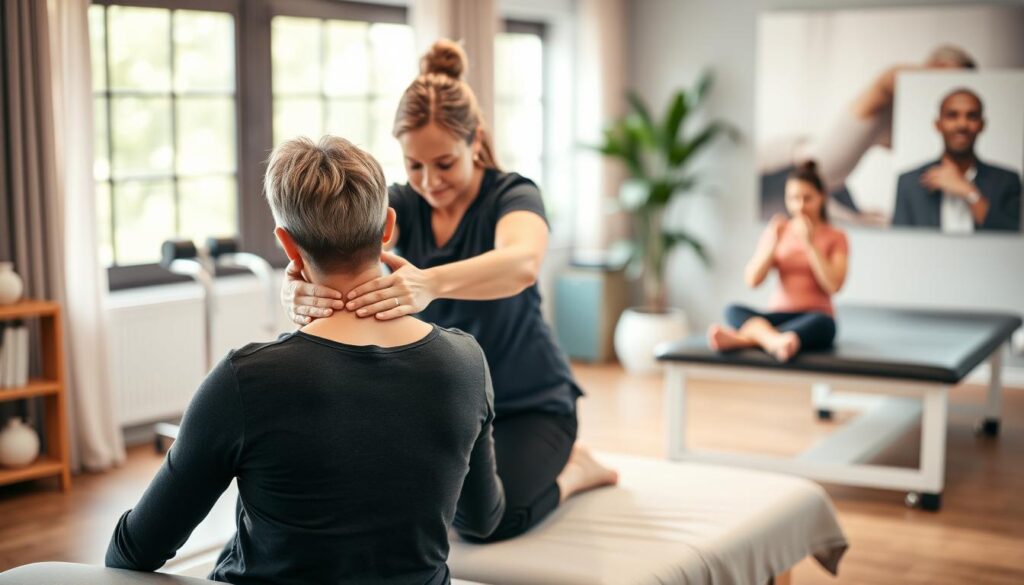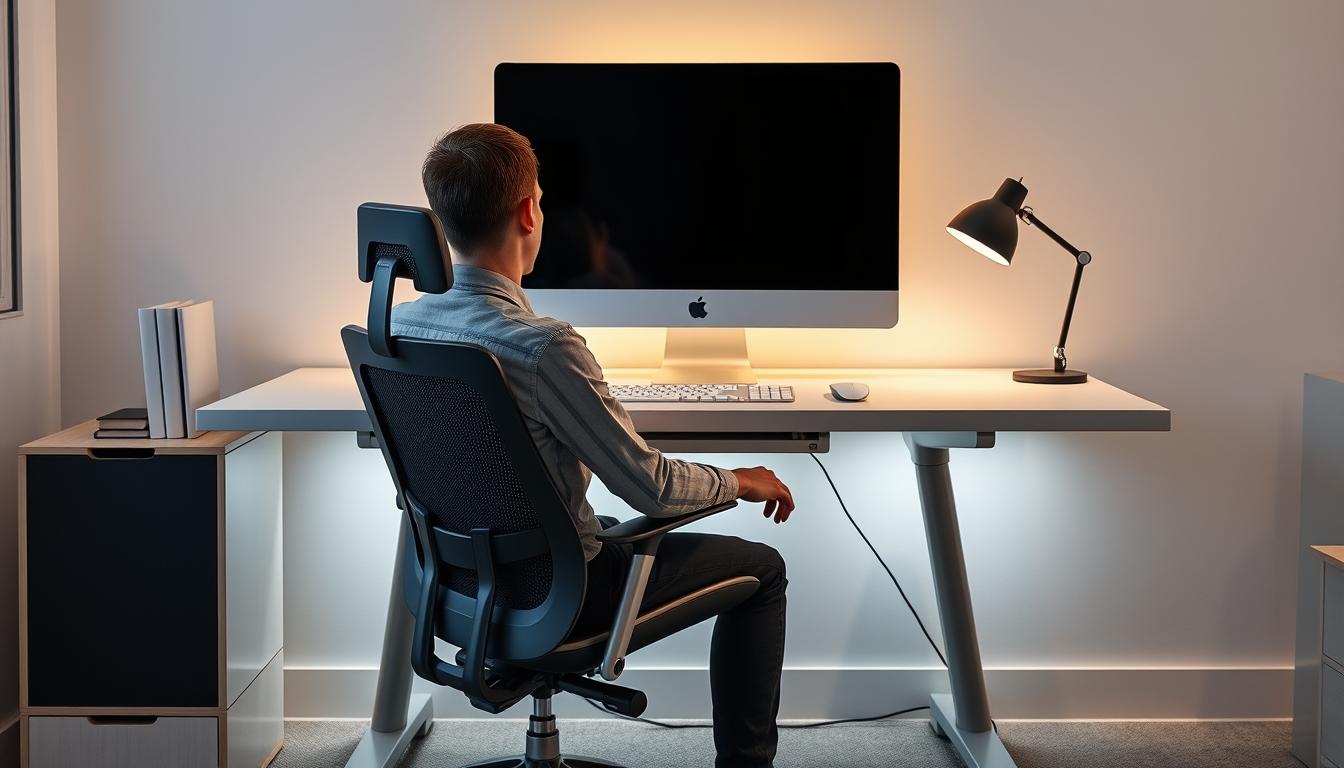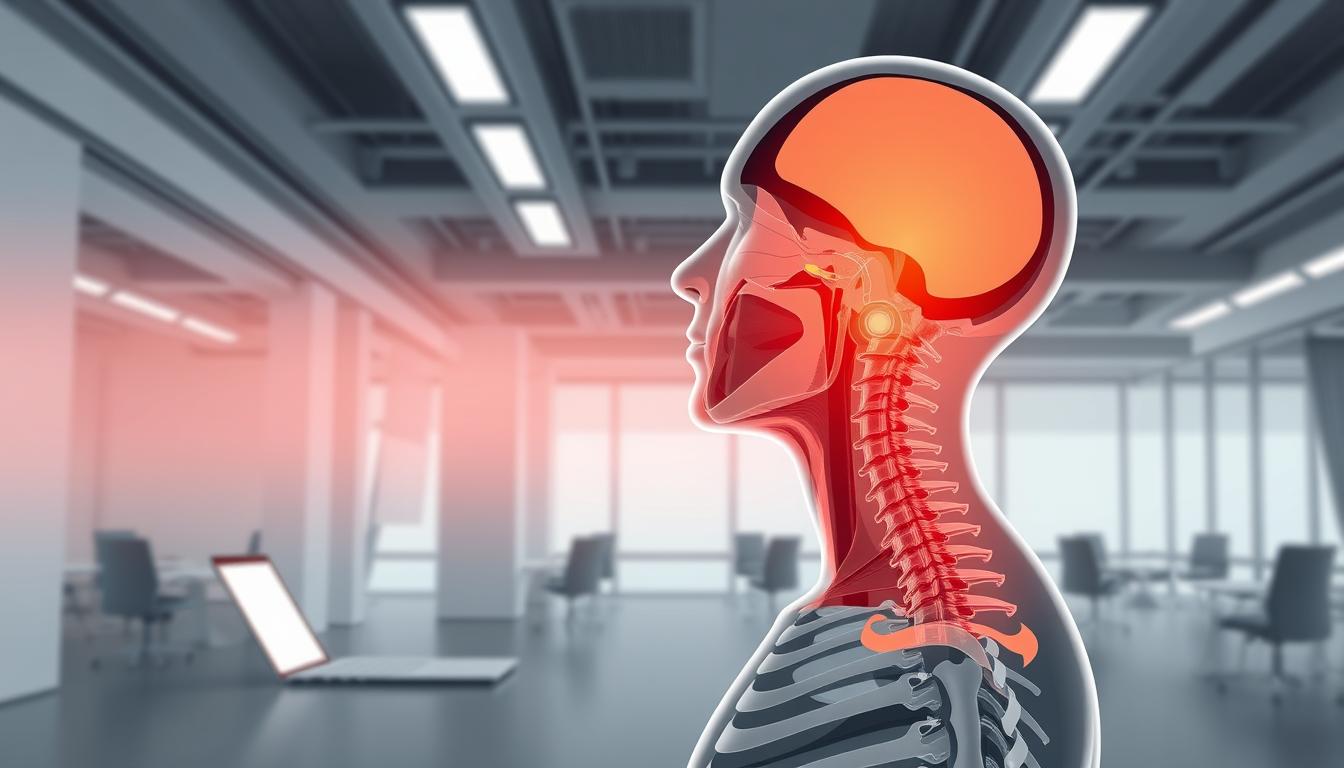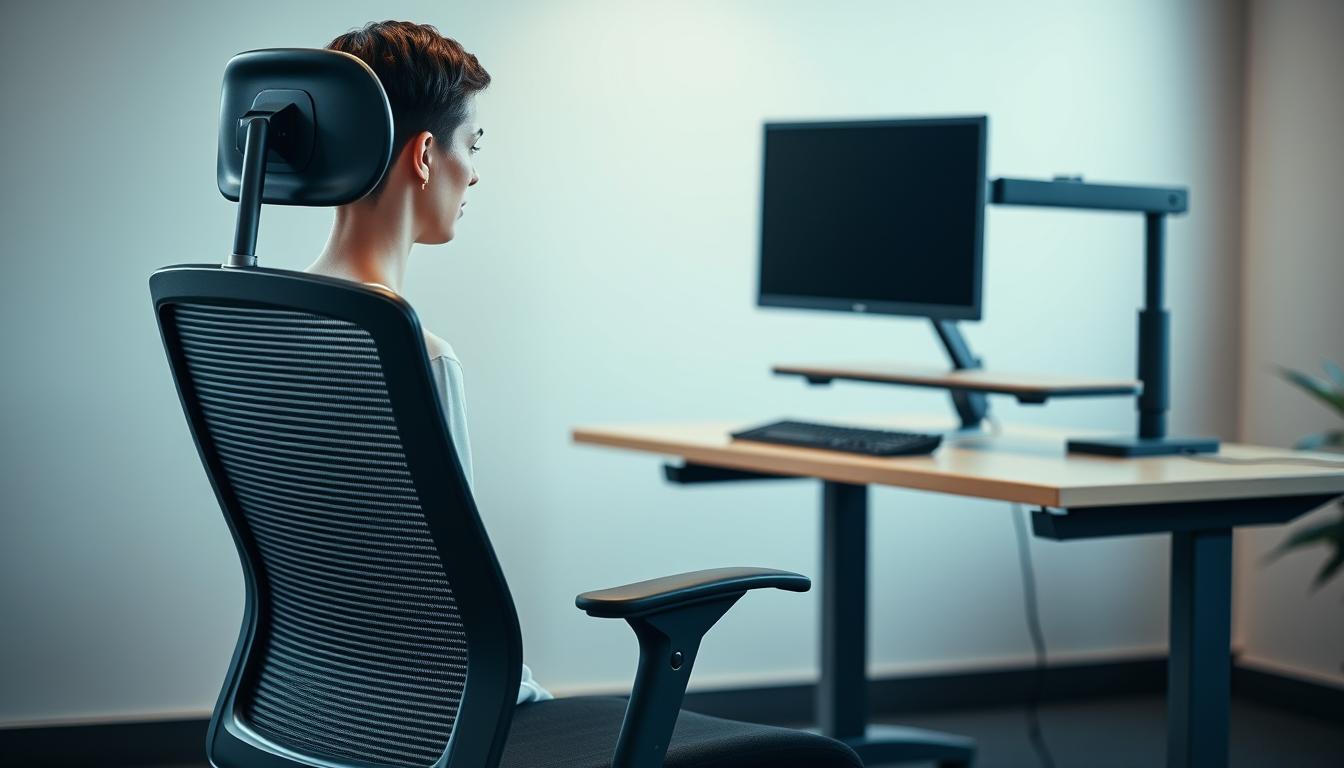The link between desk layout and neck pain isn’t always recognized. Many people working at desks feel neck pain after long hours. A good ergonomic setup can prevent neck pain and improve work.
Chair height, where your screen is, and where your keyboard is placed matter a lot. They change how your body feels after sitting for a long time. Understanding how desk layout affects neck pain can make us healthier and more productive.
Understanding Neck Pain in Desk Workers
Neck pain is common among those who sit at desks for long hours. This discomfort can lower work performance and affect one’s happiness. It’s important to know the symptoms of neck pain for proper treatment.
Common Symptoms of Neck Pain
Desk workers often feel stiff in their necks. They might have sharp pains near their skull. They could also suffer from tension headaches.
- Stiffness in the neck
- Sharp discomfort near the skull
- Tension headaches
These issues get worse the longer one sits. It’s crucial for people who work at desks to notice these early symptoms. This helps avoid more serious problems later on.
The Impact of Prolonged Sitting
Sitting for too long is bad for the neck. It causes muscle tiredness and poor blood flow, which puts more pressure on the neck. Studies show that lots of desk workers have back or neck pain because of these reasons. Being aware of the harms of sitting too much is key for them to take care of their necks.
Common Causes of Neck Pain from Desk Work
People who sit at desks a lot often suffer from neck pain. It’s vital to know why this pain happens when sitting for too long. A bad setup and not sitting right are major reasons for this issue. Making small changes in how we sit and work daily can help get rid of the pain.
Poor Posture and Ergonomics
Slouching or keeping your head too forward can strain your muscles a lot. If your monitor or keyboard is not in the right spot, it makes your neck sit badly. Over time, these bad habits can lead to neck pain.
To avoid these problems, you should fix your working space. This helps you sit up straight and avoid neck pain.
Repetitive Strain from Desk Activities
Doing the same things over and over, like typing or using a mouse, can hurt your neck. These actions tire out your muscles and can turn into lasting neck pain if not taken care of. To lessen this strain, take breaks and change up your activities during the day.
How Desk Layout Impacts Neck Pain
A well-organized desk is key to avoiding neck pain for those who work at desks. It’s important to have the right screen height, keyboard placement, and a supportive chair. These elements help improve posture and lessen discomfort.
Importance of Screen Height
The right screen height helps keep your neck comfortable. Your monitor should be at or just below eye level. This stops you from bending your head too much, which can cause strain.
Keyboard and Mouse Positioning
Placing your keyboard right can cut down on neck and shoulder tension. Your elbows should be close to your body, and your wrists straight when typing. Also, having the mouse close keeps your arms relaxed, reducing pain chances.
The Role of Chair Support
An ergonomic chair with good lumbar support is crucial. It keeps the spine’s natural curve supported, easing neck and shoulder stress. This helps you stay comfortable, focused, and productive all day.
Posture Matters: Sitting vs. Standing
It’s super important for desk workers to sit right. Sitting wrong can make your neck hurt. Good chairs support your back and stop pain. Sitting correctly makes work easier and more comfortable.
Best Practices for Sitting Posture
For good sitting posture, here’s what to do:
- Keep the back straight against the chair.
- Feet should rest flat on the ground or a footrest.
- Elbows should form a right angle while using the keyboard and mouse.
- Align the head with the spine, avoiding leaning forward.
- Adjust the chair height to maintain proper ergonomics.
Benefits of Using a Sit-Stand Desk
Having a desk where you can sit or stand is awesome for office workers. It lets you move all day. This is great for your health and lowers pain risk.
Research shows these desks really help with neck and back pain. Switching between sitting and standing is good for your blood flow. It makes you healthier and more focused at work.
Recognizing Triggers for Neck Pain
Finding out what causes neck pain means knowing the common mistakes in how we set up our workspaces. Many people who work at desks do things that can make their necks hurt without realizing it. By looking at both the environment and how we act, we can make our work areas better and reduce neck pain.
Common Ergonomic Mistakes
Making ergonomic mistakes is a big reason for neck pain. Here are some usual problems:
- Positioning screens too low, forcing users to bend their necks.
- Using chairs that lack adequate support, leading to poor posture.
- Placing keyboards too far away, resulting in awkward wrist angles.
These issues can make a space worse for your comfort, so it’s important to fix them.
Identifying Personal Pain Points
To understand what specifically makes your neck hurt, assessing personal discomfort helps. It’s good to keep a journal to track:
- Activities that cause immediate discomfort.
- Postures that yield prolonged pain or fatigue.
- Any improvements or changes after making ergonomic adjustments.
By paying attention to these details, you can create a plan that suits your needs and makes your workspace healthier.
Small Adjustments for Big Relief
Minor changes to your workspace can help ease neck pain. Adjusting your chair, using footrests, and making sure your back is supported will make you more comfortable. These simple changes will make working for long hours easier.
Adjusting Your Chair Height
Adjusting your chair is a key first step for better ergonomics. Make sure your feet are flat on the ground or a footrest. Your knees should be level with your hips to help with blood flow and lessen neck and shoulder strain.
Utilizing Footrests and Back Support
Footrests are very helpful. They support your feet and help maintain a good sitting posture. A good back support takes the pressure off your spine. Focus on these to keep your body well-aligned and reduce discomfort while you work.
Movement’s Role in Neck Pain Prevention
Making movement a part of your day is key to stopping neck pain. People who work at desks sit a lot, which makes their necks and shoulders hurt and feel stiff. To fix this, start moving more to feel better overall.
The Need for Regular Breaks
Taking breaks to move is important for easing neck pain. Try the 20-8-2 rule: work 20 minutes, stand for 8, and move for 2 minutes. This helps your muscles relax and stops them from getting sore.
Incorporating Stretching into Your Routine
Add stretches to your day to avoid neck pain. Do simple moves like neck rolls and shoulder shrugs. These keep your muscles working well and flexible. Stretching fights stiffness and improves your posture, which is really important for people who sit a lot.
The Benefits of Ergonomic Workstations
Making workstations ergonomic is key to improving productivity and cutting down on pain for desk workers. A workspace designed well with the right tools not only increases comfort but also job happiness. Picking the right office gear is the first step toward a healthier work environment that boosts both productivity and well-being.
Choosing the Right Office Equipment
To choose office equipment wisely, it’s important to invest in adjustable chairs, proper monitor stands, and ergonomic keyboards. These help maintain a natural body position, reducing strain on your neck and back. Here are the things to look for:
- Chairs with lumbar support for better back alignment
- Monitor stands that allow screens to be at eye level
- Keyboards and mice designed to reduce wrist strain
Creating an Inviting Work Environment
An inviting work setting greatly enhances team spirit and productivity. A clean and beautiful space sparks creativity and lowers stress. Pay attention to these elements:
- Incorporate natural light to improve mood and focus
- Add plants to enhance air quality and aesthetics
- Use calming colors to reduce visual stress
Physical Therapy and Neck Pain Relief
Physical therapy is a great way to deal with neck pain. It offers a plan just for you, aiming to fix your posture. This plan also includes stretches and exercises to ease your pain.
What to Expect from Physical Therapy
When you see a physical therapist, they’ll check how well your neck moves. They use different methods to help you heal. Manual therapy is one way to make your neck move better and feel less stiff.
After understanding your needs, your therapist comes up with a recovery plan. This plan is made just for you.
Exercises That Help Alleviate Pain
Adding exercises for neck pain relief is key to feeling better. Many exercises help by stretching and strengthening your muscles. For example, doing gentle neck stretches, shoulder rolls, and isometric exercises.
Doing these regularly not only eases pain. It also helps control neck pain over time.

Maintaining Long-term Neck Health
Keeping your neck healthy over time means doing certain things every day. Stretching well is key to making your neck flexible and less tight. Stretching helps strengthen the muscles around your neck, making it feel better.
Developing a Daily Stretching Routine
To stay healthy, it’s important to stretch every day. Your routine can include different moves like:
- Neck rolls to enhance mobility
- Shoulder shrugs to release tension
- Upper back stretches to improve posture
Adding these stretches to your daily routine helps ease tightness. It also helps keep your neck healthy overall.
Importance of Follow-ups with Professionals
Seeing professionals regularly helps catch neck problems early. Working with a physical therapist or chiropractor can make your exercise plan just right for you. These experts give advice that changes with your job and life, keeping your neck healthy for a long time.
Conclusion
It’s really important to understand how your desk setup affects neck pain. Setting up your desk the right way can make you more comfortable and help you work better. By learning and using tips to ease neck pain, like adjusting your chair and where your monitor sits, you can feel a lot better.
Adding some movement and stretching to your day is key to getting rid of neck pain. Taking breaks to exercise can change everything for you. Small changes can bring big improvements over time.
Also, getting advice from experts, such as physical therapists, is a smart move for keeping your health on track. Putting effort into a healthy work environment and following these tips can lead to a life without pain. This encourages better health and work performance.



